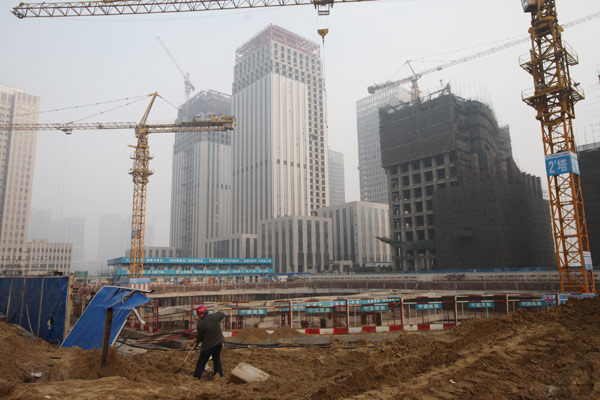Are cities expanding too fast and too soon?
Updated: 2013-04-23 08:07
By Xue Lan (China Daily)
|
||||||||
|
Construction of a business district in Tianjin. As Chinese cities compete with each other to become the latest global city, some experts question whether such expensive development is needed and cost-effective. Provided to China Daily |
Editor's Note: A great deal of hope has been invested in the role urbanization can play in helping to drive the nation's next cycle of economic boom. But how can China manage what no other country has ever achieved before, to build so many urban communities in such a short space of time?
To do things right, Premier Li Keqiang recently said that China will have to learn from other nations' experiences. Now Professor Xue Lan, dean of Tsinghua University's School of Public Policy and Management, joins the discussion by sharing his concerns and reporting his observations.
China's urbanites outnumbered its rural residents for the first time in history in 2011 and keep increasing steadily. With this achievement, urbanization has become a hot topic that many hope can be a new engine for economic growth.
However, without serious solutions to address the unprecedented challenges facing Chinese cities, these great aspirations may come unstuck, as this high-speed urbanization is partly powered by certain distorted mechanisms.
First-tier cities or not, many urban centers in China share the ambition of becoming international, national or regional metropolises, playing the role of financial, industrial or cultural centers. Accordingly, their planning, infrastructure and population have all scaled up, leading to a greater need for investment.
But does a country need so many financial, industrial or cultural centers? This lack of provident planning has increased the danger of vicious competition for investment and the risk of a waste of resources.
Smart plans
Planning authorities may gain wisdom from the experience of cities in other countries.
For example, Santa Barbara, a small but beautiful city in California, gives a holistic and peaceful impression. Anybody who has flown to that city from China must have been impressed by the simplicity of its airport, for in China, regardless of the size of the city, it has to construct a grand airport if it is to have one.
The harmony and pragmatism demonstrated in Santa Barbara's city planning is very much needed in China's urbanization, if China is to have fewer stereotyped cities and minimize the waste of resources.
Also, opportunities for industries to thrive are never reserved exclusively for metropolises. The headquarters of Hallmark Cards, the largest manufacturer of greeting cards in the United States, is located in Kansas City, Missouri. Starting from this less well-known city in the midwestern US, Hallmark cards are now sold all over the world, and the company has consolidated annual revenue of around $4 billion.
Hallmark Cards was not based on depending on one city for all its resources and convenience, but on the pursuit of excellence, and keeping its research and development center there. Pursuit of excellence is part of the city's culture, which has also greatly benefited a lot of other companies.
Other than the poorly conceived and potentially wasteful plans, local governments in China also have problems in their hasty moves to promote urbanization. Projects that take decades to complete in other countries are often finished in four or five years.

 Children gathered together as healing process begins
Children gathered together as healing process begins
 Fears surface after hippo kills tourist from Shanghai
Fears surface after hippo kills tourist from Shanghai
 Rescuers win people’s hearts
Rescuers win people’s hearts
 Law to curb tourism price hikes
Law to curb tourism price hikes
 House damaged, life continues in Sichuan
House damaged, life continues in Sichuan
 Relief reaches isolated village
Relief reaches isolated village
 Rainfall poses new threats to quake-hit region
Rainfall poses new threats to quake-hit region
 Funerals begin for Boston bombing victims
Funerals begin for Boston bombing victims
Most Viewed
Editor's Picks

|

|

|

|

|

|
Today's Top News
Industry faces recovery fight
China's 2nd aircraft carrier will be 'larger'
China thanks countries
for quake relief aid
China, US to enhance mutual trust
Beijing protests Diaoyu incident
Copyrights take a bite out of Apple
Four new H7N9 cases
Landslide kills 9 in SW China
US Weekly

|

|







